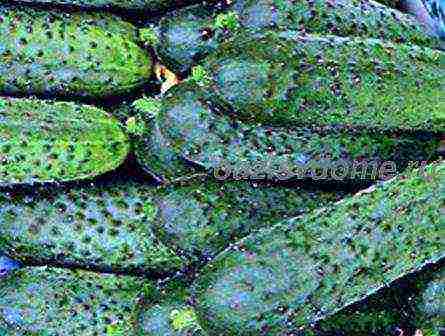Content
- 1 Soil requirements
- 2 The best predecessors of cucumbers
- 3 Fertilization for cucumbers
- 4 Soil liming
- 5 Spring processing of beds for cucumbers
- 6 Time for planting cucumbers in open ground with seeds and seedlings
- 7 Then plant cucumbers
- 8 Preparing the beds and soil for planting cucumbers in the ground
- 9 Methods for planting cucumbers in the open field
- 10 Sowing seeds
- 11 Planting cucumber seedlings in the ground in May - June
To obtain good harvest of cucumbers, it is necessary to choose the right site for their cultivation, prepare the soil and follow the rules of competent crop rotation. The culture is quite demanding on the moisture content of the soil and air, as well as in light and high temperatures, therefore, the beds for cucumbers should be broken in places protected from piercing winds, without shading.
Avoid areas with low relief - lowlands, since cold air flows into them.
Soil requirements
The best soil for growing cucumbers are considered loamy and sandy loam. The highest crop yields are obtained in high-quality fertilized fertile areas with neutral or slightly high acidity.
Cucumbers are very responsive to organic inputs. Cucumber planting requires regular and fairly frequent watering. Unsuitable for cultivation are considered uncultivated, acidic, poorly heated and heavy soils with a shallow arable layer.
The best predecessors of cucumbers
According to the rules of crop rotation, the most suitable predecessors of cucumbers are considered
- potato,
- onion,
- cabbage,
- tomato
- various green manure plants (alfalfa, clover, mustard, rye, oats, etc.).
It is strongly not recommended to plant cucumbers after all the plants of the pumpkin family: watermelon, melon, squash, squash, cucumber, pumpkin, since they consume the same nutrients from the soil, depleting it, and have the same diseases and pests.
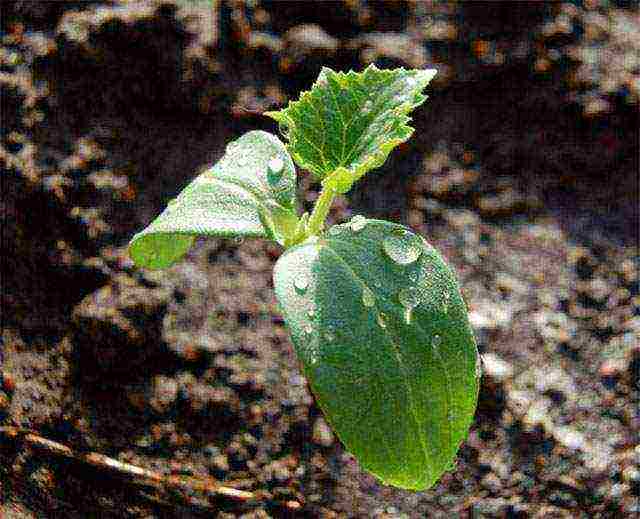
Fertilization for cucumbers
The amount of nutrients (in a form readily available for a plant) in the ground should be sufficient, since the root system of cucumbers is located in the upper layers of the soil and is characterized by a relatively high rate of their consumption.
For a short growing season, cucumbers create not only a powerful leaf apparatus, but also a lot of fruits. That's why a sufficient amount of organic matter must be introduced, which, decomposing, supplies the roots with additional portions of carbon dioxide.
Organic fertilizers for cucumbers
Fresh manure on cucumber beds brought in most often in the fall. Transforming into humus, it structures the soil, loosening heavy clay and binding sandy ones. If the soil in the garden is heavy clay or loamy, slowly warming up, then it is advisable to embed fresh manure into it 30-50 days before sowing the seeds (immediately after the snow melts) - this leads to rapid heating. On high-quality organic soils fertilized, the efficiency of mineral fertilizers increases several times.
The composition of manure contains the following useful elements: nitrogen, potassium, phosphorus, calcium. Fresh manure application rates in autumn, depending on the quality of the soil, fluctuate from 6 to 9 kg / sq. m (for light soils, less is required, for heavy soils, more).
In the spring, shortly before sowing, humus is introduced into the soil at the rate of about 4 kg per square meter. meter. It is also advisable to use compost as fertilizer in the spring.
Peat application only makes sense on heavy damp soils, as it improves the structure and its physical properties.
Mineral fertilizers for cucumbers
When cultivating cucumbers, use mineral fertilizers and ash, which can act as a full replacement for potash compounds. The ash is covered at the rate of about 200 grams per square meter. meter. Mineral fertilizers are required to be added during spring digging of the earth: ammonium nitrate - 15 g / sq. m, superphosphate - 40 g / sq. m, potassium salt (in the absence of ash) - 25 g / sq. m.
If you are using complex fertilizers, then when adding them, you should be guided by the instructions and dosages indicated on the package. Most of the minerals are added immediately before sowing or when sowing seedlings and seeds in the holes, and the rest in the form of liquid root dressings.
Soil liming
If the soil in your area is acidic, then it should be lime (deacidify) using dolomite flour, ground limestone, tuff. This stage of work is carried out in the fall when digging.
The simultaneous introduction of fresh manure and lime is not allowed - this leads to a chemical reaction, the result of which is the loss of valuable nitrogen.
In the autumn liming of the soil, which is carried out every 4-5 years, the rotted manure is introduced in the spring. Plant waste ash is not only a natural potassium-phosphorus fertilizer, but also a means of reducing soil acidity.
Spring processing of beds for cucumbers
Dug up from the fall plots for cucumbers, fertilized with organic matter, loosen up in the spring. If the manure was not introduced in the fall, then the humus is scattered in early spring, and the earth is dug to a depth into the bayonet of a shovel.
From the moment the snow melts to the sowing of cucumbers, it is necessary to monitor the looseness of the soil and immediately remove weeds that break through. Mineral fertilizers are applied approximately on May 20-25, they dig up the soil, level the topsoil with a rake and start planting.
Compliance with these simple recommendations allows you to get good yields of cucumbers even for novice gardeners. Next - growing cucumbers in the open field, planting care
Good luck with the new season!
Read related articles
Table of contents:
- Assessment of soil acidity
- Application of fertilizers and other substances
- Preparing cucumber beds
Since cucumbers are crops that are demanding on soil fertility, in order to obtain a rich harvest, it is most correct to worry about preparing the site for planting in advance. For cucumbers, loamy or sandy loamy loose soils are best suited, while acidic and heavy soils are of little use for this culture. Cucumbers require neutral or, in extreme cases, slightly acidic soil.Therefore, preparing the soil for planting cucumbers should begin with determining its acidity.
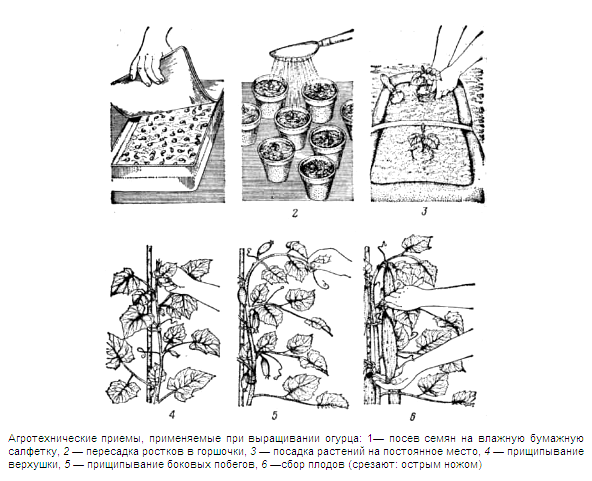
The scheme of growing cucumbers in a greenhouse.
Assessment of soil acidity
Soil acidity expresses the pH value. So, the neutral soil necessary for planting cucumbers should have a pH equal to 7. The lower the pH value, the more acidic the soil and less suitable for cucumbers. A higher pH is indicative of an alkaline soil, which is also unsuitable for a given crop.
You can analyze the acidity of the soil in a specialized laboratory. Such an analysis is carried out using a special device widely known as the Alyamovsky device. Having bought such a device, an amateur gardener, according to the instructions attached to it, will be able to independently analyze the land at a summer cottage.
Scheme of soil acidity formation.
There is a more trivial and affordable way for every amateur gardener to assess acidity using litmus paper. Such paper is sold in shops selling chemical reagents. The "secret" of this method is as follows: a 30-centimeter vertical cut of the soil is made with a shovel.The earth is moistened with distilled water or rainwater, and then part of the mixture is squeezed in the hand together with litmus paper. The color of the litmus paper is compared with a standard control scale and the acidity of the soil is determined by the color match.
In the absence of the Alyamovsky device and litmus paper, an approximate estimate of the acidity can be made by the weeds growing on the site of the upcoming planting of cucumbers. Peculiar indicators of acidic soil are plantain, horsetail, Veronica oak, pikulnik, sedge, horse sorrel, mint, creeping buttercup, woodlice, ivan-da-marya, heather. In such an area, the acidity of the soil must be reduced before planting cucumbers. If wheatgrass, field bindweed, coltsfoot, garden thistle, odorless chamomile and clover grow well on the site, then the soil is either neutral or has a slight acid level and is quite suitable for whimsical cucumbers.
Back to the table of contents
Application of fertilizers and other substances 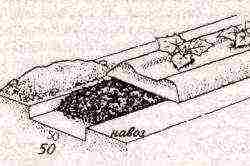
Fertilization scheme for cucumbers with manure.
Preparation of the site for planting cucumbers begins in the fall. To saturate the soil layer with minerals, it is necessary to apply fertilizers. With its low acidity, it is best to use liquid alkaline organic fertilizers. To neutralize the increased acidity of the land on the site, it is limed by the introduction of various substances, including slaked lime, dolomite flour, cement dust, chalk, defecate or ash.
With the arrival of the first warm spring days, the earth must be dug to a depth of at least 25 centimeters. After that, the upper, about 12 centimeters, layer of soil is thoroughly mixed with a rake with a layer of humus harvested in the fall. Well-prepared humus is a real "gold" for a gardener and a guarantee of a future harvest. To prepare it, you can use all kinds of organic substances, for example, sawdust, dried grass, fallen leaves, straw, manure, pieces of paper, and so on. After watering, the area chosen for growing cucumbers is covered with a film for several days so that the earth warms up to at least 150 C.
If soil preparation for some reason has not been started in the fall, then a simplified version of spring activities is needed. In this case, the introduction of lime materials must be excluded, it is allowed to apply liquid alkaline organic fertilizers and an increased dose of humus at least a week before sowing seeds or planting seedlings.
Back to the table of contents
Preparing cucumber beds
Sowing seeds or planting seedlings should be done only when the threat of frost has passed. In order to get a guaranteed harvest of cucumbers, it is best to grow them on a hill, where both good heating of the roots of a thermophilic culture and their protection from excess moisture are provided. That is why, at least a week before sowing seeds or planting seedlings, it is necessary to form beds so that the earth settles somewhat.
When arranging a plot for growing cucumbers, it is optimal to make several beds with a height of 20-30 cm, depending on the type of soil: the heavier it is, the greater the height of the bed. The width of the paths formed between the beds should be at least 0.5 meters. In addition, when using the vertical type of cultivation, in which cucumbers are woven along a net fixed on a special frame, it is necessary to place the beds in such a way that the nets do not obstruct each other.
With the advance preparation of the beds, it is necessary to water them and remove weeds, since cucumbers cannot stand their presence.
Preparing the soil for cucumbers is the first step in growing this crop.

Preparing the soil for cucumbers
It is very important to choose the right land, its location. Fertilizers are also needed. Let's consider the features of preparation in more detail.
Soil requirements
First you need to choose the area where the cucumbers will grow. It is desirable that it be turned to the south, because these vegetables love a sunny place without drafts. It is necessary to take into account what previous crops were grown here. It's good if it was potatoes, tomatoes, cauliflower, root vegetables, legumes. You should not plant greens in the place where zucchini, squash, eggplants grew. After them, microorganisms accumulate in the soil, which then lead to plant diseases.
The land for planting cucumbers should be:
- loose;
- structured;
- fertile.
Therefore, in open areas, it is better to choose light loamy or sandy soils that have good water permeability. It is important that they contain a lot of humus. Cold peat bog soils are considered completely unsuitable for growing cucumbers. They contain little phosphorus, potassium, magnesium and other trace elements. The peat land warms up slowly in the spring and cools quickly in the fall.
Acceptable soil acidity for cucumbers 6-7 units. At a pH level of 6-6.1 units, the greatest return of the plant is observed. After all, such indicators of acidity contribute to the formation of the maximum number of female flowers.
Cucumbers prefer moist soil and therefore require frequent watering. 75-85% soil moisture is optimal for crop cultivation.
The temperature of the soil before planting cucumbers is also important. It should be approximately equal to the air temperature or lower by 2-3˚С. The best indicator for seed germination is 25-28 ° C, at which seedlings appear in 3 days. At temperatures below 14 ° C, the culture stops growing. Indicators above 40˚C will be critical.
Autumn soil preparation
Preparing the soil for cucumbers can begin in the fall.
Digging
After harvesting, plant residues and weeds must be removed from the site. If pests raged in the garden, it is worth digging up the ground. Then the beetles, larvae that hit the surface will die during the winter, and the mice will leave the site. Autumn digging is also carried out if the soil is heavy, compacted and there is a danger of trapping snow on it. Prolonged springs with slow soil warming are an excuse for such events.
Do not touch the ground in the following cases:
- plot with a slope;
- flood-prone area;
- light soils prone to erosion.
Liming
It is necessary to determine the pH level. This can be done using a special device or in the laboratory. If this is not possible, use litmus paper. To do this, take soil with a shovel from a depth of 30 cm. In a fist, squeeze it with paper, by the color of which acidity is determined.
Also, the indicator of the pH level is the plants that are on the site. If it is plantain, horsetail, Veronica Dubravnaya, pickulnik, sedge, horse sorrel, mint, creeping buttercup, wood lice, then the earth is sour. Wheatgrass, field bindweed, coltsfoot, garden thistle, odorless chamomile and clover indicate non-acidic soil or with a low acidity.
To neutralize the elevated pH level, liming is carried out with such substances as slaked lime, ash, dolomite flour, chalk, cement ash. This procedure is carried out every 4-5 years.
Organic feed
To saturate the soil with useful microelements, top dressing is done in the fall. After all, the root system of zelents is superficial and quickly absorbs substances. Organic matter, decomposing, becomes a source of carbon dioxide, which is necessary for the growth of vegetables. If the acidity of the soil is not high, liquid alkaline fertilizers should be used.
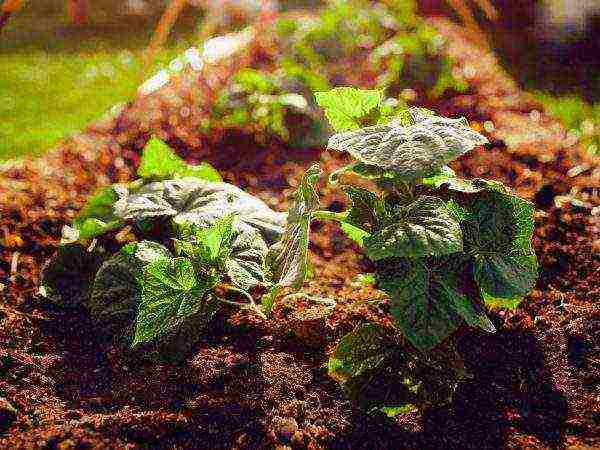
The plant needs nutrients
Preparing the soil for cucumbers can be continued with the introduction of fresh manure in the fall. It will help loosen heavy clay soils and bind sandy soils. It contains nitrogen, potassium, phosphorus, calcium. Substance consumption - per 1 sq. m. from 6 to 9 kg. If the soil is light, you need to bring in less, heavy - more.Fresh manure should not be used at the same time as lime. They react in which nitrogen is lost.
Ash is a good source of potassium and other nutrients. It is brought in at the rate of 200 g per 1 sq. m. It is also good to use compost for fertilizers.
Mulching
The effect of preparing the soil for cucumbers will be much higher if you cover its fertile layer. Mulch can be prepared from sawdust, straw, tree leaves, sunflower husks, grass. Birch leaves will be useful.
Each layer of mulch is sprinkled with earth. Some organic matter decomposes before spring. Mulching is well done on structural soils, so that plant roots can easily grow into it.
Spring soil preparation
If it was not possible to improve the beds in the fall, it must be done in the spring. Lime substances should not be added; liquid alkaline organic fertilizers can be used. They dig up the soil, deepening the shovel by 25-30 cm.
Spread a layer of 12 cm with a rake, mixing it with a lot of humus. It is prepared using sawdust, dried grass, fallen leaves, straw, manure, pieces of paper, etc. The bed is moistened and covered with a film so that the earth warms up. These activities are performed a few days before planting the culture.
The soil for cucumbers, dug up and fertilized in the fall, should be loosened in the spring. It is necessary to scatter humus on the site and dig it up to the depth of the shovel bayonet. This is done in early spring, if manure was not applied in the fall. Before planting cucumbers, it is necessary to ensure that weeds do not appear, it is necessary to remove them in time.
Mineral fertilizers
Cucumbers are a culture that loves fertile land very much. Therefore, on the twentieth of May, you need to add top dressing, which is embedded in the ground during the next digging.
Of minerals used:
- ammonium nitrate - 15 g per 1 sq. m,
- superphosphate - 40 g per 1 sq. m,
- potassium salt (if ash was not used) - 25 g per 1 sq. m;
- complex fertilizers - consumption according to the instructions.
Multilayer beds
Some gardeners make special beds with their own hands for a high result of the growing process.
First, choose a sunny place. Then, in the fall, they begin to lay layers, the first from which is drainage. It can be any branches, grass, straw. They are deepened by 30-50 cm, tamped well. Above is the second layer. Fresh manure will be used as it. And so they leave until spring. During the cold period, the bed will sag well.
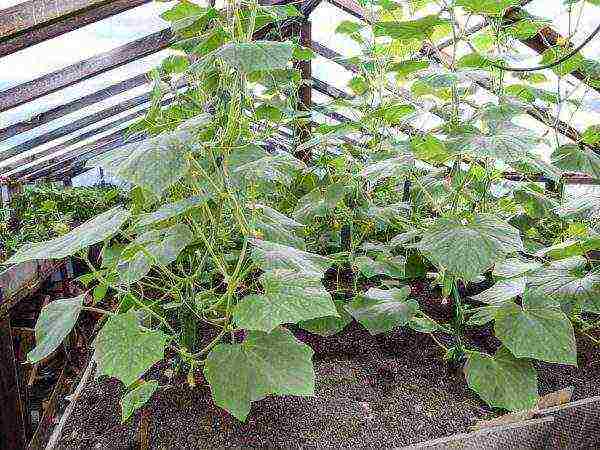
You can make the garden yourself
Actions resume in May. In the first days, the third layer is laid out - fertile soil. Humus works well. In order for the manure to begin to emit heat, they equip arcs and stretch non-woven material or film. After a few days, the area saturated with nutrients will be suitable for planting cucumbers.
You can start making a multi-layer garden in the spring. To do this, 1 sq. m. take manure in one layer, 300 g of wood ash, 100 nitrophosphate. A layer of soil is laid on top. After planting the seed, you need to stretch the arcs and cover with foil.
Compost can be used instead of manure. They begin to cook it in the summer from grass, weeds, foliage, which must be overcooked. By spring, it can be used in the garden.
Greenhouse soil preparation
In film shelters, the top layer of the earth is removed (about 5 cm). After all, it is it that contains a large number of pathogenic bacteria. Then you should dig up the ground. After that, it is disinfected. For this, the soil is treated with a 7% solution of copper sulfate. If the greenhouse is small, you can pour boiling water over the entire area before planting.
For greenhouses, a soil mixture is specially prepared to achieve maximum fruiting. It should include: sod land, peat, humus with the addition of field land. Fertilizers such as potassium sulfate, superphosphate, ammonium nitrate are added to the mixture. It is placed in a greenhouse a month after being treated with copper sulfate.
There is another way to ensure a high yield in greenhouse conditions. After removing the soil layer, manure is placed on top to a thickness of 30-40 cm. Wells are made in it, into which hot water is then poured. Manure begins to actively release heat, which fills the premises. After a few days, the temperature will be sufficient to plant the crop. Then the mixture is laid on top, which is most suitable for growing. It is prepared like this:
- 2 parts of sod land;
- 2 parts of humus;
- 1 part clean sand or sawdust.
Everything needs to be leveled. For disinfection, the mixture is poured with a pink solution of potassium permanganate.
Conclusion
Growing cucumbers involves many processes. The initial phase is very important. The yield of the crop directly depends on the preparation of the soil.
How to Grow a Cucumber - Preparing the Ground Part 1
Preparation of CUCUMBER SEEDS for sowing Germination Soaking and Germination of SEEDS before planting
Soil disinfection methods
Preparing the greenhouse in spring / Warming up the soil before planting cucumbers
SUPER SEED GROWTH AND SOAKING MEANS!
PREPARATION OF SOIL FOR POTATO, SECRETS OF YIELD OF NATURAL AGRICULTURE
If the gardener spares no effort and time for this event, he will make a great contribution to the development of culture. And she will thank him in the future with delicious fruits.
Similar articles
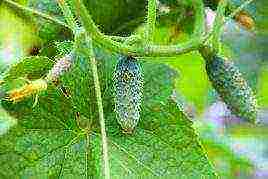
Reviews and comments
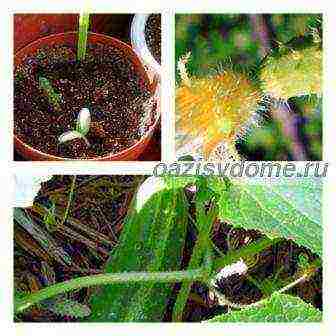
Cucumbers are grown in almost every vegetable garden in greenhouses or open ground. On the timing and schemes of planting, how to sow correctly and plant cucumber seedlings in a greenhouse you can find out if you follow the dedicated link. In this article, we will tell you in detail about planting cucumbers in open ground in spring and summer, the code and how to properly plant seeds and seedlings of cucumbers.
Time for planting cucumbers in open ground with seeds and seedlings
The timing of planting cucumbers depends on the climate of the region and the variety of the plant itself.
Sowing cucumber seeds in open ground should be after the soil warms up to +15 .. + 17 degrees at a depth of 10 cm. In cold ground, planting material will take a long time to sprout or even rot. The exact sowing time is difficult to say:
- In the suburbs and central Russia seeds can be sown from early to mid-May (depending on the weather).
- In the Urals and Siberia it is recommended to grow cucumbers in greenhouses and hotbeds under a film. Seeds can be sown in open ground only at the end of May - the first half of June.
- In the Krasnodar Territory and other warm regions seeds can be planted in the beds as early as April.
Seedlings of cucumbers are planted laterwhen the weather is warm, frosts will pass and the soil will warm up to +20 .. + 24 degrees. In regions with a warm climate, this can be done already in early May, in central Russia - from the middle of the last month, and in Siberia and more northern regions, it is better to plant cucumber seedlings in the ground in June.
According to folk signs cucumbers in open ground can be sown when peonies and viburnum are blooming. And when the acacia and lilacs bloom, you can plant seedlings in the garden.
For growing in a garden bed without shelter, you need to choose zoned varieties that are suitable for your region.
Then plant cucumbers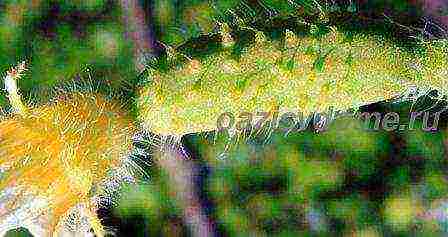
Suitable precursors for cucumbers are nutrient-rich legumes (excluding beans) and green manures, and can also be planted after tomatoes and potatoes, cabbage and salads.
Since cucumbers and melons (pumpkin, squash, squash, melon, watermelon) have the same diseases, they can be planted after each other only after three years. Also bad predecessors are beans and carrots.
Preparing the beds and soil for planting cucumbers in the ground
For culture, a sunny or light partial shade area is chosen. It must be protected from wind and drafts.
Cucumbers love soil that is loose, warm and highly fertile. They have a superficial root system, so when arranging beds of fertile soil from above, 15-20 cm will be enough.
Vegetables grow well on the soil of the following composition:
- peat - 6 parts;
- sod land - 1 part;
- sawdust - 1 part;
- humus - 1 part.
Cucumbers love manure, so before planting, the top fertile soil can be watered with a solution that is prepared in a 1: 5 ratio from manure and water. If there is no manure, chicken droppings will do. It is diluted with water in a ratio of 1:10. Today, specialty stores sell a variety of complex organic and mineral fertilizers that can be used to fertilize the soil in the absence of manure and droppings.
Garden patterns for cucumbers
Heat-loving plants grow best in warm, high beds, which can be made according to the scheme in the photo. 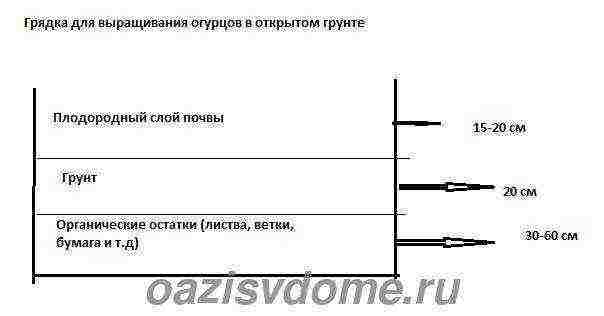 Such a bed is made in the fall:
Such a bed is made in the fall:
- A trench is dug out with a depth of 50-60 cm and various residues are laid on its bottom in the form of paper, trimmings of boards, branches, sunflower and corn stalks, foliage.
- If the bed is not very deep (30-40 cm), then use foliage, which quickly decays.
- To speed up the decay process, organic residues are poured with the Radiance or Baikal preparation.
- The bottom layer is covered with a layer of soil (20 cm).
- A fertile layer is poured on top, into which cucumbers will be planted.
If the bed will be made in the spring, manure can be added to the bottom layer. It will warm the soil and the plants will be warm.
In the absence of manure, compost can be used, but such a bed will not turn out very warm, so it is recommended to plant seeds in it germinated.
Methods for planting cucumbers in the open field
In spring (or early summer), cucumbers can be planted in the beds in two ways:
- Sowing seeds... This method of growing cucumbers in the open field is practiced mainly in areas with a warm climate.
- Transplanting... With this method, the crop can be harvested two weeks earlier than when planting cucumbers in the ground with seeds. However, cucumbers have a delicate horse system and if it is damaged during transplantation, the plants will hurt for a long time. Therefore, it is recommended to grow seedlings in peat pots.
Sowing seeds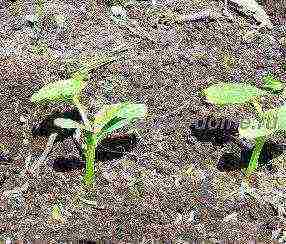
It is recommended to sow seeds in several stages, that is, not all at once, but a little every week. In this case, the crop can be harvested during the entire warm period. However, sowing later than mid-June is not recommended, since young plants do not develop well at high temperatures.
Preparing cucumber seeds for sowing in the ground
For sowing, choose a three to four year old planting material, which is recommended to be processed before sowing in the ground:
- Warming up the seeds... To make the seedlings friendly, the planting material is heated for two hours at +60 degrees, for which you can use a thermos with water. Another option is to place the seeds in the oven for three hours and heat them at 60C. Seeds are scattered in a thin layer on paper, which is spread on a baking sheet. A longer, but affordable way of heating is to place the planting material in a gauze bag and hang it over heating devices for a month (the temperature should be about +25 degrees). Attention! The seeds of hybrid varieties do not need to be heated.
- Disinfection... Treatment of seeds with solutions of potassium permanganate or garlic will help protect against many diseases of the plant. In a 1% solution of potassium permanganate, planting material is kept for 20 minutes, and in a garlic solution (30 grams of chopped garlic per 100 ml of water) - 1 hour. After that, the seeds are washed well under running water.
- Microfertilizer treatment. To soak the planting material, you can use a mixture of trace elements or only one type (boric acid, zinc sulfate or copper sulfate). Fertilizers are diluted according to the instructions with warm water and seeds are placed in them for 12 hours. Treatment with trace elements will help plants adapt faster and accelerate their development.
The processed seeds must be dried and sowing can be started.
How to sow seeds
On a prepared bed with a distance of 40-60 cm, furrows or holes are made, the depth of which should be about 2 cm. The holes and furrows are well watered. Seeds are laid flat, slightly deepening. In the furrows, the distance between the seeds should be 10-15 cm, and if wide holes were made, then 3-5 seeds are placed in each of them. The crops are covered with earth.
If on your site swampy or heavy soils, then for planting cucumbers, it is recommended to make ridges in which the seeds are placed at a depth of 1.5 cm.
When the seedlings sprout and cotyledon leaves appear on them, thinning must be carried out so that the distance between the plants is 20-25 cm. For this, weak specimens are not pulled out, but pinched.
Planting cucumber seedlings in the ground in May - June
Cucumbers ready for planting should have 3-4 true leaves. A week before planting in open ground, the seedlings begin to harden, that is, they are taken out for several hours in the open air. Containers with seedlings should be placed in the shade so that direct sunlight does not fall on the plants.
Rules for planting seedlings of cucumbers in the ground:
- On beds with a step of 60 cm, holes are made a little more deep than the height of the pot in which the seedlings grow.
- The plant is carefully removed from their containers and placed in the holes. If the seedlings grow in peat pots, then the plants are installed in the holes with them.
- The roots of cucumbers are covered with soil. The seedlings should not be planted deeply and the stem should not be covered, otherwise root rot may begin to develop.
- Plantings are watered with water (3 liters per plant).
- A grid with large cells or trellises is installed close to the holes. The growing liana will climb up on them.
Cucumbers grow and develop well at temperatures of +15 degrees, so if the air temperature is lower, then the planted plants will need to be insulated, for which a film or non-woven covering material is pulled over them on the installed arcs.